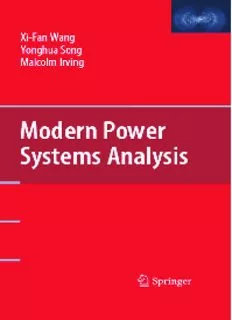
Modern Power Systems Analysis (Power Electronics and Power Systems) PDF
Preview Modern Power Systems Analysis (Power Electronics and Power Systems)
Modern Power Systems Analysis Xi-Fan Wang Yonghua Song Malcolm Irving l l Modern Power Systems Analysis 123 Xi-FanWang YonghuaSong Xi’anJiaotongUniversity TheUniversityofLiverpool Xi’an Liverpool People’sRepublicofChina UnitedKingdom MalcolmIrving BrunelUniversity Middlesex UnitedKingdom ISBN978-0-387-72852-0 e-ISBN978-0-387-72853-7 LibraryofCongressControlNumber:2008924670 #2008SpringerScience+BusinessMedia,LLC Allrightsreserved.Thisworkmaynotbetranslatedorcopiedinwholeorinpartwithoutthewritten permissionofthepublisher(SpringerScience+BusinessMedia,LLC,233SpringStreet,NewYork,NY 10013, USA), except for brief excerpts in connection with reviews or scholarly analysis. Use in connection with any form of information storage and retrieval, electronic adaptation, computer software,orbysimilarordissimilarmethodologynowknownorhereafterdevelopedisforbidden.The useinthispublicationoftradenames,trademarks,servicemarksandsimilarterms,eveniftheyarenot identifiedassuch,isnottobetakenasanexpressionofopinionastowhetherornottheyaresubjectto proprietaryrights. Whiletheadviceandinformationinthisbookarebelievedtobetrueandaccurateatthedateofgoingto press,neithertheauthorsnortheeditorsnorthepublishercanacceptanylegalresponsibilityforany errorsoromissionsthatmaybemade.Thepublishermakesnowarranty,expressorimplied,withrespect tothematerialcontainedherein. Printedonacid-freepaper. 987654321 springer.com Preface Thepowerindustry,acapitalandtechnologyintensiveindustry,isabasicnational infrastructure.Itssecurity,reliability,andeconomyhaveenormousandfar-reaching effects on a national economy. An electrical power system is a typical large-scale system. Questions such as how to reflect accurately the characteristics of modern electricalpowersystems,howtoanalyzeeffectivelytheiroperatingfeatures,andhow toimprovefurthertheoperatingperformancearealwaysattheforefrontofelectrical powersystemsresearch. Electricalpowersystemanalysisisusedasthebasicandfundamentalmeasureto study planning and operating problems. In the last century, electrical power researchers have undertaken a great deal of investigation and development in this area, have made great progress in theoretical analysis and numerical calculation, andhavewrittenexcellentmonographsandtextbooks. Overthelast20years,thechangesinelectricalpowersystemsandotherrelevant technologieshavehadaprofoundinfluenceonthetechniquesandmethodologiesof electricalpowersystemanalysis. First, the development of digital computer technology has significantly im- proved the performance of hardware and software. Now, we can easily deal with loadflowissueswithovertenthousandnodes.Optimalloadflowandstaticsecurity analysis,whichwereonceconsideredhardproblems,haveattainedonlinepractical applications. Second, the applications of HVDC and AC flexible transmission technologies (FACTS)haveaddednewcontrolmeasurestoelectrical powersystems,andhave increasedpowertransmissioncapacity,enhancedcontrolcapability,andimproved operating characteristics. However, these technologies bring new challenges into theareaofelectricalpowersystemanalysis.Wemustbuildcorrespondingmathe- matical models for these new devices and develop algorithms for static and dynamicanalysisofelectricalpowersystemsincludingthesedevices. In addition, the rapid development of communication technology has enabled online monitoring of electrical power systems. Therefore, the demand for online softwareforelectricalpowersystemanalysisbecomesmoreandmorepressing. Furthermore, worldwide power industry restructuring and deregulation has separated the former vertically integrated system into various parts, and the once v vi Preface unified problem of power system dispatching is now conducted via complicated bilateral contracts and spot markets. New issues such as transmission ancillary serviceandtransmissioncongestionhaveemerged. Inrecentyears,severalpowerblackoutshavetakenplaceworldwide,especially the‘‘8.13’’blackoutontheeasterngridofUSAandCanadaandtheblackoutsthat occurredsuccessivelyinothercountrieshaveattractedagreatdealofattention. All ofthese aspectsrequirenew theories, models,andalgorithms for electrical power system analysis. It is within such an environment that this book has been developed.Thebookiswrittenasatextbookforseniorstudentsandpostgraduates aswellasareferencebookforpowersystemresearchers. Weacknowledgethesupportfromvariousresearchfundingorganizations,their colleagues, and students, especially, the special funds for Major State Basic Re- searchProjectsofChina‘‘ResearchonPowerSystemReliabilityunderDeregulated EnvironmentofPowerMarket’’(2004CB217905).Weexpressourspecialgratitude to Professor Wan-Liang Fang and Professor Zheng-Chun Du for providing the original materials of Chaps. 5 and 6, and 7 and 8, respectively. We also express our sincere gratitude tothe following colleagues for their contributions tovarious chaptersofthebook:ProfessorZhao-HongBieforChaps.1and3;ProfessorXiu-Li Wang for Chaps. 2 and 4; Dr. Ze-Chun Hu for Chap. 3; Dr. Xiao-Ying Ding for Chap.4;Dr.LinDuanforChaps.5and6;ProfessorDe-ChiangGangforChap.7; andProfessorHai-FengWangforChaps.6and8. Xi’an,China Xi-FanWang Liverpool,UK YonghunaSong London,UK MalcolmIrving Contents 1 MathematicalModelandSolutionofElectricNetwork ................. 1 1.1 Introduction ............................................................ 1 1.2 BasicConcepts ......................................................... 2 1.2.1 NodeEquationandLoopEquation ............................ 2 1.2.2 EquivalentCircuitofTransformerandPhase ShiftTransformer .............................................. 9 1.3 NodalAdmittanceMatrix ............................................. 13 1.3.1 BasicConceptofNodalAdmittanceMatrix .................. 13 1.3.2 FormulationandModificationofNodal AdmittanceMatrix ............................................ 17 1.4 SolutiontoElectricNetworkEquations .............................. 22 1.4.1 GaussEliminationMethod .................................... 22 1.4.2 TriangularDecompositionandFactorTable ................. 27 1.4.3 SparseTechniques ............................................. 34 1.4.4 SparseVectorMethod ......................................... 38 1.4.5 OptimalOrderingSchemesofElectricNetworkNodes ...... 43 1.5 NodalImpedanceMatrix ............................................. 48 1.5.1 BasicConceptofNodalImpedanceMatrix .................. 48 1.5.2 FormingNodalImpedanceMatrixUsingAdmittance Matrix ......................................................... 50 1.5.3 FormingNodalImpedanceMatrixbyBranchAddition Method ........................................................ 56 2 LoadFlowAnalysis ......................................................... 71 2.1 Introduction ........................................................... 71 2.2 FormulationofLoadFlowProblem .................................. 73 2.2.1 ClassificationofNodeTypes ................................. 73 2.2.2 NodePowerEquations ........................................ 76 2.3 LoadFlowSolutionbyNewtonMethod .............................. 79 2.3.1 BasicConceptofNewtonMethod ............................ 79 2.3.2 CorrectionEquations .......................................... 83 vii viii Contents 2.3.3 SolutionProcessofNewtonMethod .......................... 88 2.3.4 SolutionofCorrectionEquations ............................. 89 2.4 FastDecoupledMethod .............................................. 101 2.4.1 IntroductiontoFastDecoupledMethod ..................... 101 2.4.2 CorrectionEquationsofFastDecoupledmethod ............ 104 2.4.3 FlowchartofFastDecoupledMethod ....................... 107 2.5 StaticSecurityAnalysisandCompensationMethod ................ 113 2.5.1 SurveyofStaticSecurityAnalysis ........................... 113 2.5.2 CompensationMethod ....................................... 114 2.6 DCLoadFlowMethod .............................................. 119 2.6.1 ModelofDCLoadFlow ..................................... 120 2.6.2 OutageAnalysisbyDCLoadFlowMethod ................. 122 2.6.3 N-1CheckingandContingencyRankingMethod ........... 123 3 StochasticSecurityAnalysisofElectricalPowerSystems ............ 129 3.1 Introduction .......................................................... 129 3.2 BasicConceptsofProbabilityTheory ............................... 130 3.2.1 ProbabilityofStochasticEvents ............................. 130 3.2.2 RandomVariablesanditsDistribution ...................... 132 3.2.3 NumeralCharacterofRandomVariable .................... 133 3.2.4 ConvolutionofRandomVariables ........................... 135 3.2.5 SeveralUsualRandomVariableDistributions .............. 136 3.2.6 MarkovProcess .............................................. 138 3.3 ProbabilisticModelofPowerSystems. .............................. 140 3.3.1 ProbabilisticModelofLoad ................................. 140 3.3.2 ProbabilisticModelofPowerSystemComponents ......... 141 3.3.3 OutageTableofPowerSystemComponents ................ 142 3.4 MonteCarloSimulationMethod .................................... 145 3.4.1 FundamentalTheoryofMonteCarloSimulation Method ....................................................... 145 3.4.2 SamplingofSystemOperationState ........................ 148 3.4.3 StateEvaluationModel ...................................... 150 3.4.4 IndicesofReliabilityEvaluation ............................. 151 3.4.5 FlowchartofCompositeSystemAdequacyEvaluation ..... 152 3.4.6 MarkovChainMonteCarlo(MCMC)Simulation Method ....................................................... 156 3.5 ProbabilisticLoadFlowAnalysis .................................... 161 3.5.1 CumulantsofRandomDistribution .......................... 162 3.5.2 LinearizationofLoadFlowEquation ........................ 168 3.5.3 ComputingProcessofProbabilisticLoadFlow ............. 171 3.6 ProbabilisticNetwork-FlowAnalysis ................................ 178 3.6.1 Introduction .................................................. 178 3.6.2 Network-FlowModel ........................................ 180 3.6.3 LowerBoundaryPointsofFeasibleFlowSolutions ........ 186 3.6.4 ReliabilityofTransmissionSystem .......................... 188 Contents ix 4 PowerFlowAnalysisinMarketEnvironment ......................... 193 4.1 Introduction .......................................................... 193 4.1.1 TransmissionOwner ......................................... 193 4.1.2 IndependentOperator ........................................ 194 4.1.3 PowerExchange .............................................. 194 4.1.4 AncillaryService ............................................. 195 4.1.5 SchedulingCoordinator ...................................... 195 4.2 OptimalPowerFlow ................................................. 196 4.2.1 GeneralFormulationofOPFProblem ....................... 196 4.2.2 ApproachestoOPF ........................................... 198 4.2.3 InteriorPointMethod(IPM)forOPFProblem .............. 202 4.3 ApplicationofOptimalPowerFlowinElectricityMarket .......... 217 4.3.1 Survey ........................................................ 217 4.3.2 CongestionManagementMethodBasedOnOPF ........... 223 4.4 PowerFlowTracing .................................................. 228 4.4.1 CurrentDecompositionAxioms ............................. 230 4.4.2 MathematicalModelofLossAllocation .................... 232 4.4.3 UsageSharingProblemofTransmissionFacilities .......... 234 4.4.4 MethodologyofGraphTheory .............................. 238 4.5 AvailableTransferCapabilityofTransmissionSystem ............. 241 4.5.1 IntroductionToAvailableTransferCapability .............. 241 4.5.2 ApplicationofMonteCarloSimulationinATC Calculation ................................................... 245 4.5.3 ATCCalculationwithSensitivityAnalysisMethod ........ 246 5 HVDCandFACTS ....................................................... 255 5.1 Introduction .......................................................... 255 5.2 HVDCBasicPrinciplesandMathematicalModels ................. 258 5.2.1 HVDCBasicPrinciples ...................................... 258 5.2.2 ConverterBasicEquationsNeglectingLc ................... 261 5.2.3 ConverterBasicEquationsConsideringLc ................. 267 5.2.4 ConverterEquivalentCircuits ............................... 273 5.2.5 MultipleBridgeOperation ................................... 276 5.2.6 ConverterControl ............................................ 279 5.3 PowerFlowCalculationofAC/DCInterconnectedSystems ....... 281 5.3.1 ConverterBasicEquationsinperUnitSystem .............. 282 5.3.2 PowerFlowEquations ....................................... 283 5.3.3 JacobianMatrixofPowerFlowEquations .................. 286 5.3.4 IntegratedIterationformulaofAC/DC InterconnectedSystems ...................................... 289 5.3.5 AlternatingIterationforAC/DCInterconnectedSystems ... 294 5.4 HVDCDynamicMathematicalModels ............................. 299 5.5 BasicPrinciplesandMathematicalModelsofFACTS ............. 301 5.5.1 BasicPrincipleandMathematicalModelofSVC ........... 302 5.5.2 BasicPrincipleandMathematicalModelofSTATCOM ... 308 x Contents 5.5.3 BasicPrincipleandMathematicalModelofTCSC ......... 313 5.5.4 BasicPrincipleandMathematicalModelofSSSC .......... 319 5.5.5 BasicPrincipleandMathematicalModelofTCPST ........ 322 5.5.6 BasicPrincipleandMathematicalModelofUPFC ......... 325 6 MathematicalModelofSynchronousGeneratorandLoad .......... 333 6.1 Introduction .......................................................... 333 6.2 MathematicalModelofSynchronousGenerator .................... 335 6.2.1 BasicMathematicalEquationsofSynchronous Generator ..................................................... 336 6.2.2 MathematicalEquationsofSynchronousGenerator UsingMachineParameters ................................... 343 6.2.3 SimplifiedMathematicalModelofSynchronous Generator ..................................................... 351 6.2.4 Steady-StateEquationsandPhasorDiagram ................ 354 6.2.5 MathematicalEquationsConsideringEffect ofSaturation .................................................. 357 6.2.6 RotorMotionEquationofSynchronousGenerator .......... 360 6.3 MathematicalModelofGeneratorExcitationSystems ............. 363 6.3.1 MathematicalModelofExciter .............................. 365 6.3.2 VoltageMeasurementandLoadCompensationUnit ....... 375 6.3.3 Limiters ....................................................... 376 6.3.4 MathematicalModelofPowerSystemStabilizer ........... 377 6.3.5 MathematicalModelofExcitationSystems ................. 377 6.4 MathematicalModelofPrimeMoverandGoverningSystem ...... 381 6.4.1 MathematicalModelofHydro-Turbine andGoverningSystem ....................................... 382 6.4.2 MathematicalModelofSteamTurbine andGoverningSystem ....................................... 389 6.5 MathematicalModelofLoad ........................................ 393 6.5.1 StaticLoadModel ............................................ 395 6.5.2 DynamicLoadModel ........................................ 397 7 PowerSystemTransientStabilityAnalysis ............................ 405 7.1 Introduction .......................................................... 405 7.2 NumericalMethodsforTransientStabilityAnalysis ................ 407 7.2.1 NumericalMethodsforOrdinaryDifferentialEquations ... 408 7.2.2 NumericalMethodsforDifferential-Algebraic Equations ..................................................... 425 7.2.3 GeneralProcedureforTransientStabilityAnalysis ......... 427 7.3 NetworkMathematicalModelforTransientStabilityAnalysis ..... 430 7.3.1 TheRelationshipBetweenNetworkandDynamicDevices . 431 7.3.2 ModelingNetworkSwitchingandFaults .................... 439
